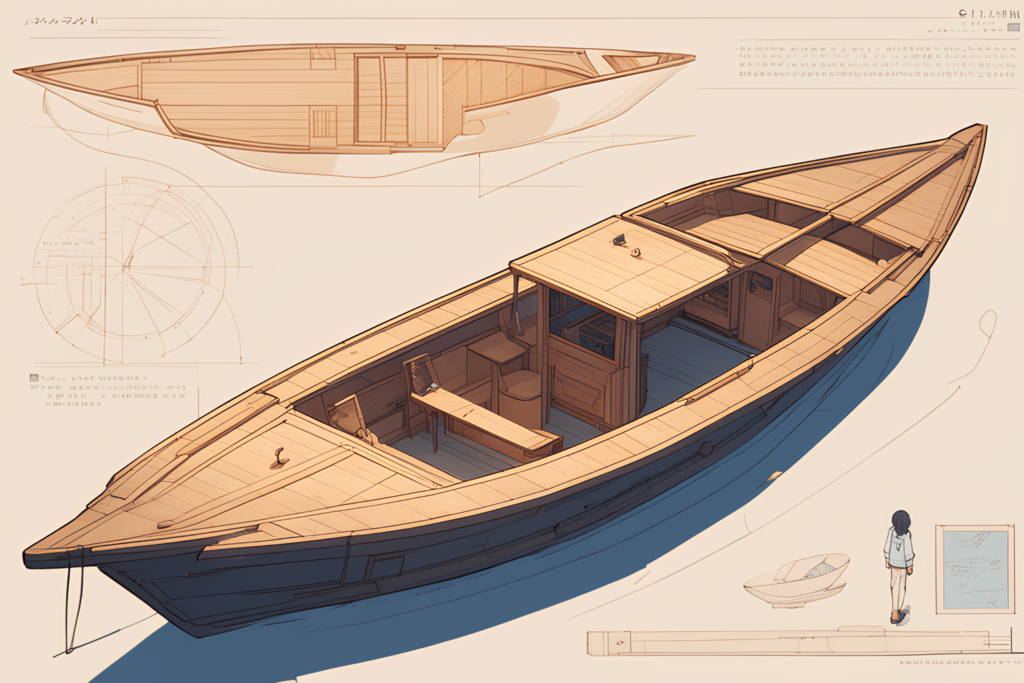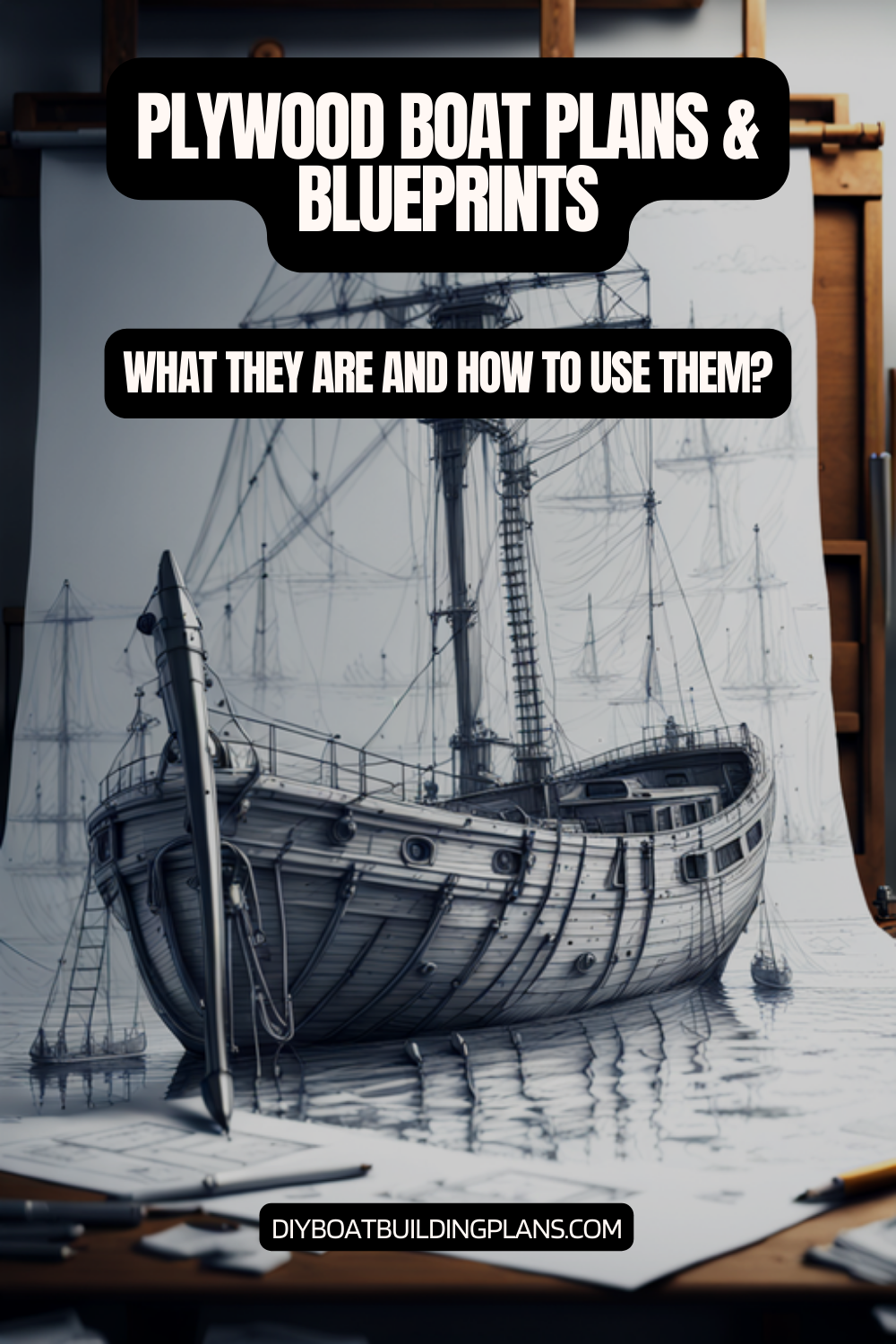Overview of Plywood Boat Plans & Blueprints
Plywood boat plans and blueprints have been gaining significant attention in the world of DIY boat building. These detailed technical drawings and specifications have become a go-to resource for individuals seeking to construct their own boats using the versatile and cost-effective material of plywood. In this comprehensive article, we will delve into the world of plywood boat plans, exploring their advantages, the process of selecting the right design, and the step-by-step guide to building your own plywood boat.
Plywood boat plans and blueprints are the detailed technical documents that provide the necessary information for constructing a plywood boat. These plans typically include precise measurements, material specifications, and step-by-step instructions for the entire building process. The rise in popularity of DIY plywood boat building can be attributed to several factors, including the affordability of the materials, the flexibility in design options, and the sense of accomplishment that comes with creating a functional watercraft from scratch.
As more people become drawn to the idea of building their own boats, the demand for high-quality plywood boat plans and blueprints has increased. These resources have become invaluable tools for both novice and experienced boat builders, allowing them to navigate the construction process with confidence and precision. Whether you’re looking to build a small dinghy for recreational use or a larger vessel for more adventurous excursions, plywood boat plans can provide the foundation for your project.
Key Takeaways
- Plywood boats are a great option for DIY boat builders due to their affordability and ease of construction.
- Choosing the right plywood boat design is crucial for ensuring a successful build.
- Understanding plywood boat plans and blueprints is essential before starting construction.
- Essential tools and materials for plywood boat construction include a jigsaw, drill, epoxy, and marine-grade plywood.
- Troubleshooting common challenges in plywood boat building, such as leaks and warping, can save time and frustration in the long run.

The Advantages of Building a Plywood Boat
One of the primary advantages of building a plywood boat is the cost-effectiveness compared to traditional boat construction methods. Plywood, being a relatively inexpensive material, can significantly reduce the overall budget required for a boat-building project. This makes it an attractive option for those with limited financial resources or who are looking to explore the world of boat building without a substantial investment.
In addition to the cost-effectiveness, plywood boat plans offer a high degree of versatility in design and customization options. These plans often provide a range of boat styles, sizes, and configurations, allowing builders to choose a design that aligns with their intended use, skill level, available space, and personal preferences. This flexibility enables DIY enthusiasts to create a boat that is truly unique and tailored to their specific needs.
The durability and longevity of plywood boats are also noteworthy advantages. When properly constructed and maintained, plywood boats can withstand the rigors of the water and provide years of reliable service. The use of epoxy resins and other protective coatings ensures that the plywood structure remains watertight and resistant to the elements, making these boats a sound investment for those who plan to use them regularly.
Perhaps one of the most rewarding aspects of building a plywood boat is the sense of accomplishment and personal satisfaction that comes with the process. Transforming a set of plans and raw materials into a functional and seaworthy vessel is a truly gratifying experience. The hands-on nature of plywood boat building allows individuals to develop new skills, problem-solve challenges, and take pride in their craftsmanship, creating a deep connection with the final product.
Choosing the Right Plywood Boat Design
When it comes to building a plywood boat, the selection of the right design is a crucial step in the process. Several factors must be considered, including the intended use of the boat, the builder’s skill level, the available space for construction, and the overall budget.
Intended use is a primary consideration when choosing a plywood boat design. Are you looking to build a small dinghy for recreational activities, a larger sailboat for coastal cruising, or a sturdy fishing boat? Each of these applications will require a different set of design characteristics, such as hull shape, size, and weight capacity. Carefully evaluating the intended use will help narrow down the selection of plywood boat plans and ensure that the final product meets your specific needs.
The builder’s skill level is another important factor to consider. Plywood boat plans range in complexity, from simple and straightforward designs suitable for novice builders to more intricate and challenging projects better suited for experienced individuals. Assessing your own skills and comfort level with boat-building techniques will help you identify the appropriate plan that aligns with your capabilities and provides a manageable learning curve.
Available space for construction is also a crucial consideration. Plywood boat plans come in a variety of sizes, and it’s essential to ensure that you have adequate workspace to accommodate the boat’s dimensions during the building process. This may involve evaluating the size of your garage, workshop, or other designated building area to ensure a successful and efficient construction experience.
Finally, the overall budget for the project must be taken into account. Plywood boat plans can vary in price, and the total cost of materials and tools required can also fluctuate. By carefully reviewing the plan’s material list and cost estimates, you can determine whether the design fits within your financial constraints and make an informed decision that aligns with your budgetary considerations.
Researching and evaluating different plywood boat plans, as well as consulting with experienced builders or designers, can provide valuable guidance in the selection process. This collaborative approach can help you identify the most suitable design that meets your specific needs and ensures a rewarding and successful boat-building experience.
Understanding Plywood Boat Plans and Blueprints
Plywood boat plans and blueprints are the technical documents that serve as the foundation for the construction process. These detailed drawings and specifications provide the necessary information for builders to understand the various components of the boat and how they fit together.
Interpreting the technical drawings and specifications is a crucial step in the plywood boat-building journey. These plans typically include multiple views, such as the side profile, the top view, and the cross-sections, which allow builders to visualize the boat’s structure and dimensions. Understanding the scale, measurements, and annotations on the plans is essential for ensuring accurate construction.
Identifying the key components and their dimensions is another important aspect of comprehending plywood boat plans. These plans will outline the specific sizes and shapes of the plywood panels, frames, stringers, and other essential elements that make up the boat’s structure. Familiarizing yourself with these components and their respective measurements will help you plan the cutting and assembly process effectively.
Equally important is understanding the construction methods and sequences outlined in the plywood boat plans. These plans will provide step-by-step instructions on how to assemble the various parts, including the proper techniques for joining the plywood panels, installing the frames and stringers, and applying the necessary reinforcements. Carefully following these instructions is crucial for maintaining the structural integrity and ensuring the boat’s seaworthiness.
Recognizing the importance of accurate measurements and attention to detail cannot be overstated when working with plywood boat plans. Even the slightest deviation from the specified dimensions can have a significant impact on the final product. Builders must be meticulous in their measurements, cutting, and assembly to ensure a precise and well-fitting boat.
By thoroughly understanding the technical drawings, specifications, and construction methods outlined in the plywood boat plans, builders can approach the project with confidence and minimize the risk of costly mistakes or structural issues. This comprehensive understanding of the plans is the foundation for a successful and rewarding boat-building experience.
Essential Tools and Materials for Plywood Boat Construction
| Plan Name | Price | Number of Pages | Difficulty Level |
|---|---|---|---|
| Simple Plywood Boat Plans | 29.99 | 20 | Beginner |
| Classic Wooden Boat Plans | 49.99 | 50 | Intermediate |
| Advanced Plywood Boat Blueprints | 79.99 | 100 | Expert |
Building a plywood boat requires a well-equipped workshop and a carefully curated selection of tools and materials. Ensuring that you have the necessary power tools, hand tools, and building supplies can make the construction process more efficient and increase the chances of a successful outcome.
The power tools essential for plywood boat building include a circular saw, a jigsaw, a router, and a belt sander. These tools will be instrumental in accurately cutting the plywood panels to the required dimensions and shaping the various components. Additionally, a drill and a set of drill bits will be necessary for creating the necessary holes and fastening the boat’s structure together.
Alongside the power tools, a comprehensive set of hand tools is also crucial. This includes a tape measure, a square, a level, clamps, and a variety of screwdrivers and wrenches. These tools will aid in the precise measurement, alignment, and assembly of the boat’s components, ensuring a tight and secure fit.
The selection of the appropriate plywood and other building materials is a critical aspect of the construction process. Builders must carefully choose the type and thickness of plywood that aligns with the boat’s design and intended use. Additionally, the selection of adhesives, such as epoxy resins, and fasteners, such as screws and nails, is essential for creating a strong and watertight structure.
Ensuring a well-equipped workspace is also crucial for efficient boat building. This may involve setting up a dedicated building area with adequate space, proper lighting, and the necessary storage solutions for tools and materials. A well-organized and clean workspace can greatly enhance the construction experience and minimize the risk of errors or accidents.
By investing in the right tools and materials, and creating a well-designed workspace, builders can approach the plywood boat construction process with confidence and efficiency. This preparation will pay dividends throughout the building journey, leading to a successful and rewarding outcome.
Step-by-Step Guide to Building a Plywood Boat
Building a plywood boat from scratch can be a rewarding and fulfilling experience, but it requires a methodical approach and attention to detail. Following a step-by-step guide based on the provided plywood boat plans can help ensure a successful construction process.
The first step in the process is preparing the building jig or mold. This temporary structure serves as the foundation for the boat’s construction, providing the necessary support and shaping the hull. Builders must carefully follow the instructions in the plywood boat plans to accurately construct the jig, ensuring that it aligns with the specified dimensions and curvatures.
Once the building jig is in place, the next step is cutting and assembling the plywood panels. This involves carefully measuring, marking, and cutting the plywood to the exact specifications outlined in the plans. Builders must pay close attention to the grain direction and the placement of the panels to maintain the structural integrity of the boat.
After the plywood panels are cut, the next step is applying epoxy and reinforcing the hull and deck. This process involves coating the panels with a high-quality epoxy resin, which serves as a waterproofing and strengthening agent. Builders must also incorporate reinforcing materials, such as fiberglass or carbon fiber, to enhance the boat’s durability and resistance to stress.
The final stages of the construction process involve completing the interior and exterior finishes. This may include installing bulkheads, seats, and other interior components, as well as applying the final coats of paint or varnish to the exterior of the boat. Attention to detail and adherence to the plywood boat plans are crucial during this phase to ensure a professional-looking and functional end result.
Throughout the entire construction process, builders must be mindful of the importance of accurate measurements, proper alignment, and attention to detail. Any deviations from the plywood boat plans can have a significant impact on the boat’s structural integrity and performance. By following the step-by-step guide and carefully executing each phase of the construction, builders can increase their chances of creating a seaworthy and visually appealing plywood boat.
Troubleshooting Common Challenges in Plywood Boat Building
Building a plywood boat, while immensely rewarding, can also present various challenges along the way. Addressing these challenges effectively is crucial for ensuring a successful and satisfactory outcome.
One common issue that can arise is the warping or deformation of plywood panels. This can occur due to factors such as improper storage, exposure to moisture, or the inherent properties of the wood. Builders must be vigilant in monitoring the plywood panels and take proactive measures to prevent or mitigate warping, such as properly conditioning the wood and using clamping techniques during the assembly process.
Ensuring proper alignment and structural integrity is another critical aspect of plywood boat building. Deviations from the specified dimensions or improper assembly can compromise the boat’s stability and seaworthiness. Builders must carefully follow the instructions in the plywood boat plans, double-check measurements, and utilize jigs or templates to maintain the correct alignment throughout the construction process.
Dealing with leaks or water intrusion is another common challenge that plywood boat builders may face. Proper application of sealants, such as epoxy resins, and attention to detail in the construction process are essential for creating a watertight structure. Builders should also be prepared to troubleshoot and address any potential leaks that may arise during the boat’s initial water testing.
The finishing and painting process can also present its own set of challenges. Achieving a professional-looking and durable finish requires careful preparation, the use of appropriate paints and varnishes, and a keen eye for detail. Builders may encounter issues such as uneven application, bubbling, or peeling, and must be prepared to address these problems through sanding, reapplying the finishes, and troubleshooting the underlying causes.
By anticipating and addressing these common challenges, plywood boat builders can navigate the construction process with greater confidence and increase the likelihood of a successful and satisfying outcome. Seeking guidance from experienced builders, consulting the plywood boat plans thoroughly, and maintaining a problem-solving mindset can all contribute to overcoming these obstacles and creating a high-quality, seaworthy boat.
Finishing Touches: Painting, Varnishing, and Outfitting Your Plywood Boat
The final stages of building a plywood boat involve the application of protective coatings, the installation of necessary hardware, and the addition of personal touches to create a truly unique and functional watercraft.
Choosing the right paints, varnishes, and protective coatings is crucial for ensuring the long-term durability and aesthetic appeal of the boat. Builders must carefully research and select products that are specifically formulated for marine environments, as they need to withstand exposure to water, UV radiation, and other environmental factors. Proper surface preparation, such as sanding and cleaning, is essential for achieving a smooth and even application of these finishes.
Applying the finishes with care and attention to detail is the next step. This may involve multiple coats of paint or varnish, with each layer carefully cured and sanded to achieve a professional-looking result. Builders should follow the manufacturer’s instructions and be prepared to troubleshoot any issues that may arise, such as bubbling, peeling, or uneven coverage.
Once the protective coatings have been applied, the next step is to install the necessary hardware, such as cleats, oarlocks, and seating. These components not only enhance the functionality of the boat but also contribute to its overall aesthetic. Builders must carefully plan the placement and installation of these items, ensuring that they are securely fastened and integrated seamlessly with the boat’s design.
The final touches involve customizing the boat with personal elements that reflect the builder’s style and preferences. This may include adding custom graphics, installing specialized equipment (such as fishing rod holders or a sail system), or incorporating unique design features. These personalized touches can transform the plywood boat into a truly one-of-a-kind creation that the builder can take great pride in.
By meticulously applying the finishes, installing the necessary hardware, and adding personal touches, builders can transform their plywood boat into a visually stunning and highly functional watercraft. This attention to detail and craftsmanship is the culmination of the entire boat-building process, showcasing the builder’s skills and dedication to creating a truly remarkable vessel.
Launching and Maintaining Your Homemade Plywood Boat
The final and perhaps most exciting step in the plywood boat-building journey is the launch and ongoing maintenance of the completed vessel. Proper preparation and care are essential to ensure the long-term enjoyment and safety of your homemade boat.
Safely transporting and launching the completed boat is the first crucial step. Builders must carefully plan the logistics of moving the boat from the workshop to the launch site, taking into account the boat’s size, weight, and any necessary equipment or assistance. Once at the launch site, the proper techniques for safely lowering the boat into the water must be followed to avoid damage or accidents.
Performing regular maintenance and inspections is key to ensuring the longevity and seaworthiness of your plywood boat. This includes checking for any signs of wear or damage, such as cracks, delamination, or water intrusion, and addressing them promptly. Routine cleaning, waxing, and the application of protective coatings can also help preserve the boat’s appearance and structural integrity.
Proper storage during the off-season is another important aspect of maintaining a plywood boat. Depending on the climate and the boat’s design, builders may need to consider options such as indoor storage, covered outdoor storage, or even winterizing the boat to protect it from the elements. Adhering to the manufacturer’s recommendations and best practices for storage can help extend the boat’s lifespan and ensure it is ready for the next season of use.
Finally, the true reward of building a plywood boat is the opportunity to enjoy it on the water. Whether it’s a leisurely day of cruising, a fishing expedition, or an adventurous journey, the sense of accomplishment and pride that comes with operating a boat you’ve built yourself is truly unparalleled. Embracing the fruits of your labor and creating lasting memories on the water is the ultimate culmination of the plywood boat-building experience.
By carefully launching, maintaining, and enjoying your homemade plywood boat, you can ensure that your investment of time, effort, and skill pays dividends for years to come. The satisfaction of navigating the waters in a vessel you’ve constructed with your own hands is a truly rewarding and unforgettable experience.

Conclusion – Plywood Boat Plans & Blueprints
Finish the boat with care, applying paint, varnish, or epoxy resin as per the finishing guide. This step ensures not only a beautiful appearance but also protection from water damage and UV rays. Be patient and meticulous during the finishing process, as it contributes to the overall durability and aesthetics of your plywood boat.
Download over 500 Boat Plans. Click on the link below.
-->Click Here<--
In summary, plywood boat plans and blueprints are indispensable guides for anyone interested in boat building. Whether you’re a beginner or an experienced builder, these plans offer a wealth of benefits, including precision, cost savings, and customization options. Selecting the right plan for your specific needs is crucial, and following the plans with meticulous attention to detail will result in a boat that brings satisfaction and joy.
If you avoid common mistakes, make the most of expert tips, and take your time throughout the process, you’ll be well on your way to creating a boat that meets your unique vision. With the right plans, tools, and a dose of creativity, you can embark on an exciting journey of building a plywood boat that you can be proud of. Happy boat building!
FAQs – Plywood Boat Plans & Blueprints
What are plywood boat plans and blueprints?
Plywood boat plans and blueprints are detailed instructions and diagrams that guide boat builders in constructing a boat using plywood as the primary material.
What types of boats can be built using plywood boat plans and blueprints?
Plywood boat plans and blueprints can be used to build a variety of boats, including kayaks, canoes, sailboats, rowboats, and powerboats.
What materials are needed to build a boat using plywood boat plans and blueprints?
The materials needed to build a boat using plywood boat plans and blueprints include plywood sheets, epoxy resin, fiberglass cloth, marine-grade lumber, screws, nails, and other hardware.
Do I need to have previous boat-building experience to use plywood boat plans and blueprints?
While previous boat-building experience can be helpful, it is not necessary to use plywood boat plans and blueprints. The instructions and diagrams are designed to be easy to follow, even for beginners.
Where can I find plywood boat plans and blueprints?
Plywood boat plans and blueprints can be found online, in boating magazines, and at specialty boat-building stores. Some plans may be available for free, while others may require a purchase.
How long does it take to build a boat using plywood boat plans and blueprints?
The time it takes to build a boat using plywood boat plans and blueprints can vary depending on the size and complexity of the boat, as well as the builder’s experience and skill level. Some boats can be built in a few weeks, while others may take several months.
What are the benefits of building a boat using plywood boat plans and blueprints?
Building a boat using plywood boat plans and blueprints can be a rewarding and cost-effective way to own a boat. It allows for customization and personalization, and can be a fun and fulfilling hobby. Additionally, plywood is a lightweight and durable material that is easy to work with.



